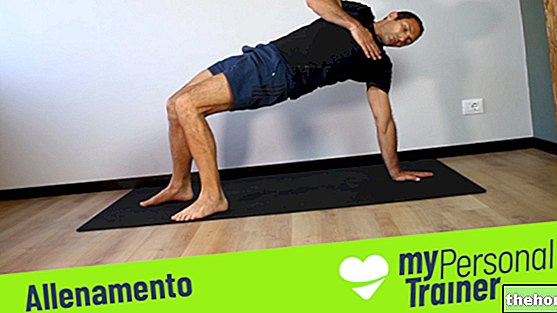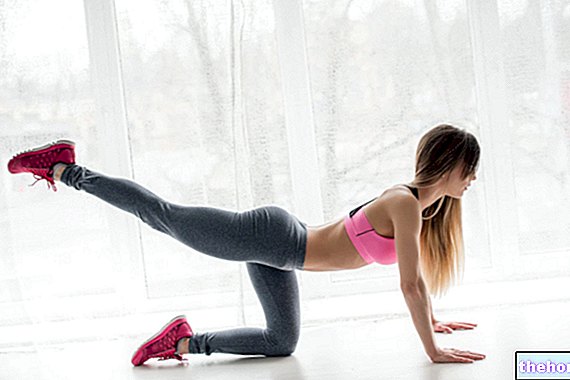Watch the video
- Watch the video on youtube
curated by Selena Mercandelli and Elena Vitale
. The shoulders loosen, the back tones up, the neck loses stiffness, the ankles and knees are strengthened, the leg muscles become more elastic and gain strength.
The positions of the warriors work on the third chakra, Manipura, which can be placed at the "height of the navel", in the solar plexus, thus working decisively on the abdominal muscles.
The meaning
Virabhadra is a proud warrior, which Hinduism wants to be born from a hair of the god Shiva. Warrior 2, of which there are also variants, belongs to the group of standing asanas and is polar, it is performed first on one side and then on the other. The warrior awakens our inner strength, gives tone to the body and strengthens the will.
When you practice
Virabhadrasana 2, like all standing positions, greatly strengthens the lower body, works on grounding, leg and abdomen strength. Practice this asana when you feel weak and hesitant and need to gain confidence in yourself. Look well for grounding in order to aspire to reach heaven.
Sequence and repetitions
Stand on the mat with your legs about three feet apart with your hands in prayer in front of your chest. Inhale deeply, spread your arms outwards with your palms facing down, pull your hands tightly keeping them active, lower your shoulders, keeping them away from your ears and turn your gaze to the back of your right hand. Keep your gaze fixed. in one spot to help you keep your balance.
Now rotate the pelvis to the right, open the toe of the right foot, extend the left leg well back, checking that the two heels are parallel and the pelvis wide open in front, bend the right knee and keep the left leg taut and active, having the left foot rotated at 45 degrees and close to the ground. Feel the weight of your body equally distributed on your feet.
Gradually go down with the pelvis until you reach knee height. Inhale, lift the torso up and open the heart trying to join the shoulder blades behind, exhaling lower the pelvis a little more. Keep the abdomen very strong to protect the lumbar area.
Stay in the position for five breaths, then, inhaling straighten your legs, rotate your pelvis towards the center and repeat everything on the other side.
Because it is good
The Warrior 2 stance works on the muscles of the legs, abdomen and back. Increases lung capacity and chest expansion. It tones the arms, shoulders and ankles, fortifying them to help us perform better balance positions.
The work on the third Chakra (solar plexus) and on the fourth Chakra (heart) leads to a great expansion of the heart and an energetic strengthening of these points, leading us to live with greater courage, willpower and openness towards others.
and in the neck, it strengthens the ankles and develops the chest. It increases blood flow to the lower spine area, invigorates the abdominal muscles and strengthens the hip muscles.The meaning
In Sanskrit, utthita means "extended", parsva means "lateral" and kona "angle". This position is then literally translated as "the position of the" extended lateral angle ".
When you practice
Utthita Parvakonasana is a polar position, that is, it must be performed on both sides of the body. In Yoga the positions are repeated first on one side and then on the other to balance the muscular and energetic work that is performed on the body.
It is one of the positions that characterize the ashtanga yoga sequence and can be performed whenever we want to work on opening the hips and side.
Sequence and repetitions
Stand on the mat with your legs wide apart, starting from Tadasana, the mountain position. Feel your feet firmly rooted to the ground, inhale and then exhale, open the right leg and turn the toe to the right, descend into a lateral lunge, bending the right knee to 90 degrees and stretch the left leg well back, rooting the foot on the ground turned at 45 degrees. Feel that the weight of the body is equally distributed on both legs.
Place the right forearm on the right thigh, extend the left arm upwards, creating a single line between the outer cut of the left foot and the tip of the hand. If you can, bring your right palm to the ground, rest your shoulder against your knee, and continue to stretch your left arm creating space in your rib and bringing a slight twist to your spine.
If you feel particularly flexible, you can pass with your right arm under the thigh and grabbing the left wrist, keeping the side open and looking up. Stay for five breaths, then slowly exit the position. Repeat everything on the other side.
Because it is good
Utthita Parsvakonasana is a very powerful asana because it works on the second chakra (area of the gonads) and on the second chakra (solar plexus), bringing a very strong energy charge to these areas which are strongly supplied by the blood. Its constant practice increases strength and resistance.
On a physical level, the muscles of the legs and the joints of the legs, knees and ankles are strengthened. The groin area, the spinal column are reinforced in an important way. Thanks to the expansion of the chest and shoulders that the asana involves, the lung capacity is amplified.
We just have to get all on the mat!
This training is done in partnership with Yogaessential




























